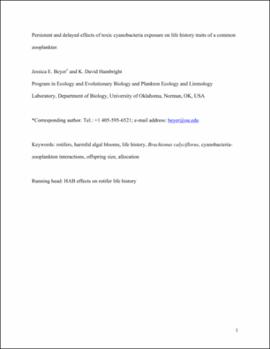| dc.contributor.author | Beyer, Jessica E. | |
| dc.contributor.author | Hambright, K. David | |
| dc.date.accessioned | 2020-10-29T15:33:14Z | |
| dc.date.available | 2020-10-29T15:33:14Z | |
| dc.date.issued | 2015-12-15 | |
| dc.identifier.citation | Beyer, J. E., and K. D. Hambright. (2016) Persistent and delayed effects of cyanobacteria exposure on life history traits of a common zooplankter. Limnology & Oceanography 61(2): 587-595. https://aslopubs-onlinelibrary-wiley-com.ezproxy.lib.ou.edu/doi/full/10.1002/lno.10239 | en_US |
| dc.identifier.uri | https://hdl.handle.net/11244/325635 | |
| dc.description.abstract | Anthropogenic eutrophication has resulted in shifts in phytoplankton community composition worldwide which represent dramatic changes in resource quality and availability for grazers such as rotifers. For these grazers, harmful algal blooms may have consequences that persist across several generations. We hypothesized that rotifers exposed to a pulse of the toxigenic cyanobacterium Microcystis aeruginosa, would suffer demographic and physiological effects that decreased their ability to recover after cyanobacteria exposure. Additionally, we hypothesized that rotifer population recovery after harmful algal blooms is modulated by delayed effects of pre‐bloom food availability. We used laboratory experiments to test the effects of switching from a high quality diet to toxigenic cyanobacteria on the physiological condition and associated life history changes of the common rotifer Brachionus calyciflorus. We found that M. aeruginosa exposure decreased fecundity of rotifers by 51.5%, and early exposure to high levels of the high‐quality food Chlamydomonas sp. did not ameliorate this negative effect. Rotifers exposed to Microcystis produced lower quality offspring (by 16.6%). However, we found that the effect of Microcystis on offspring body size was dependent on the density of food available in early life. Exposure to high‐density food for the first 3 d of life tempered the negative effects of Microcystis exposure, whereas initial exposure to low‐density food resulted in a 9.0% decrease in offspring length. We found that the negative effects of exposure to toxigenic cyanobacteria may accumulate across generations and limit the ability of rotifer populations to withstand the predicted increasing frequency and duration of harmful algal blooms. | en_US |
| dc.description.sponsorship | Funding was provided by the Oklahoma Department of Wildlife Conservation (through the Sport Fish Restoration Program, Grant F‐61‐R to KDH), the University of Oklahoma Department of Biology, and OU Biological Station (through a Graduate Research Fellowship to JEB). | en_US |
| dc.language | en_US | en_US |
| dc.subject | Rotifers | en_US |
| dc.subject | Harmful algal blooms | en_US |
| dc.subject | Life history | en_US |
| dc.subject | Brachionus calyciflorus | en_US |
| dc.subject | Cyanobacteriazooplankton interactions | en_US |
| dc.subject | Offspring size | en_US |
| dc.subject | Allocation | en_US |
| dc.title | Persistent and delayed effects of toxic cyanobacteria exposure on life history traits of a common zooplankter | en_US |
| dc.type | Article | en_US |
| dc.description.peerreview | Yes | en_US |
| dc.identifier.doi | 10.1002/lno.10239 | en_US |
| ou.group | College of Arts and Sciences::Department of Biology | en_US |
